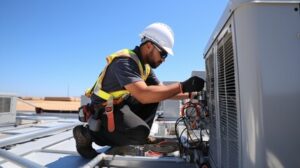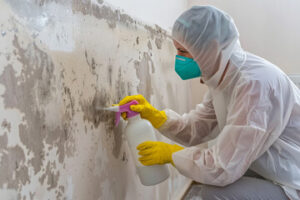HVAC (heating, ventilation and air conditioning systems) technology manipulates indoor environment temperature and air quality. The system works by filtering air, removing dust, allergens, and excess moisture.

The air is then blown through ductwork, heated or cooled and distributed to rooms through vents or registers. The thermostat regulates the process. For professional help, call Ausco Air Heating & Air Conditioning.
Working conditions refer to the physical and social aspects of a job that create an environment conducive to work. They include a safe workplace, reasonable working hours, and fair wages. The concept of working conditions gained traction in the 19th century with labor movements that advocated for better wages and safer workplaces.
HVAC systems help improve working conditions by providing clean, breathable air. They also provide thermal comfort by heating and cooling a building’s rooms. The HVAC system consists of several components, including the air handler, ductwork, thermostat, and ventilation piping. The air handler is a large metal box that contains the furnace and air conditioner, and it distributes heated or cooled air throughout a building using ductwork. The thermostat is a sensor inside the home that tells the air handler when to turn on and off.
A properly functioning HVAC system will not only keep workers comfortable, but it will also ensure that the quality of the air they breathe is consistent with federal and state standards. It will also reduce the amount of energy used to heat and cool buildings, which will save money for homeowners or businesses.
To ensure that the HVAC system is operating at its best, it is important to perform routine maintenance on a regular basis. This will catch any minor problems that may be developing before they become major issues. In addition, routine maintenance will make the system more efficient and reduce its energy costs.
HVAC contractors can be found in many locations across the country. They can be found in the local phone book or online, and most offer free consultations to discuss what needs to be done to fix a problem or upgrade an existing system. They can also help homeowners understand the terms and conditions of their warranty, as well as give them advice on how to improve the performance of their system. A good contractor will be honest about any potential problems that might arise, and will provide a detailed estimate before the repair or replacement is completed. They will also be able to recommend other services that can be done to increase the efficiency of the HVAC system.
Increased Efficiency
Energy efficient HVAC systems operate with lower consumption levels, resulting in reduced energy bills. They also tend to have longer lifespans than their traditional counterparts, cutting down on maintenance costs. Using technologies like programmable thermostats and variable-speed motors, these systems optimize their operation to match the actual heating and cooling demands of the building. This minimizes wasted energy, reducing the overall environmental impact of the system.
Moreover, energy-efficient equipment utilizes renewable or clean sources to help reduce emissions of greenhouse gases and other pollutants. This further promotes sustainable development and a greener world.
HVAC systems account for a large share of a home or business’s energy usage, but they can be made more efficient through proactive maintenance and careful design. For example, ductwork should be properly sealed to prevent air leakage that could increase the energy required for heating and cooling. Another option is demand-controlled ventilation that allows heating or cooling to be delivered only when people are present. This helps reduce the amount of energy used while improving indoor comfort.
High efficiency HVAC systems are also designed with superior construction and intelligent operating systems, minimizing wear and tear. This can result in significant savings on repair and replacement costs, as well as improved air quality and temperature control for occupants.
When choosing an energy-efficient HVAC system, look for one with a SEER rating of 14.5 or higher. This rating measures the cooling output in BTUs over a single season divided by the power input in watt-hours. In 2023, SEER ratings will be replaced with an EER rating that defines how efficiently an AC operates at a single outdoor temperature.
Upgrading to a new, energy-efficient HVAC system can be a good investment for both residential and commercial customers. The upfront cost is often offset by the long-term energy savings and federal tax credits. This past year, the energy-efficient HVAC tax credit was worth up to 30% of the cost of the system, which makes it a great time for businesses and homeowners to invest in an eco-friendly HVAC solution.
Reduced Maintenance Costs
HVAC (heating, ventilation and air conditioning) is the system of technologies for controlling the temperature, humidity, and purity of indoor air. It is a subdiscipline of mechanical engineering, and its design is based on the principles of thermodynamics, fluid mechanics, heat transfer, and electrical engineering.
A well-maintained HVAC system can save you money on heating and cooling costs. It also reduces the need for costly repairs and replacement of equipment. However, it is important to choose the right system for your home or business based on the size and climate conditions where you live. Moreover, a properly maintained system is more efficient and helps the environment by reducing carbon emissions.
The most effective way to reduce maintenance costs is through a combination of rescheduling and eliminating wasteful tasks. This requires a commitment to the implementation of a formal maintenance management process. This includes establishing performance metrics and an organization-wide commitment to continuous improvement.
It is critical that facilities teams have access to accurate and complete maintenance records. This ensures that they can make informed decisions about asset life cycle and potential problems before it is too late. In addition, easy-to-find documentation allows facilities teams to avoid the trap of becoming “firefighters” caught in a reactive maintenance cycle where they constantly spend more money fixing what has already broken.
Most HVAC systems have a 10-15 year lifespan and regular maintenance can extend this lifespan. A system that is not kept up to date will wear out much sooner and require expensive repair bills. It is a good idea to invest in a maintenance plan from an established professional.
Using smart technology to monitor and control HVAC systems can improve energy efficiency, reduce maintenance costs, and help the environment. For example, new sensors can detect airborne particulates and automatically clean the ductwork to prevent mold and bacteria from growing. This can reduce the need for frequent cleaning, which can reduce energy consumption and the need for chemicals that are harmful to the environment. It can also help reduce operational costs by reducing the number of hours needed for repairs and by increasing productivity.
Environmentally Friendly
Sustainable HVAC systems use renewable energy sources like geothermal or solar power to reduce greenhouse gas emissions and minimize their impact on the environment. They also use advanced technologies, such as programmable thermostats and zoned climate control to ensure that only the necessary amounts of heat or air are used for any given time. Additionally, they help to improve indoor air quality by reducing the presence of pollutants and allergens.
A major reason for the growing popularity of eco-friendly HVAC systems is that they can save money on energy costs. The initial investment may be higher, but in the long run, a more environmentally friendly system can pay for itself through lower energy bills. Additionally, many governments offer rebates and incentives for installing green technology, making the upfront cost more manageable.
As the world shifts towards sustainability, HVAC is at the forefront of this movement. Innovative technologies are being developed that are poised to make a big difference in the way that buildings are operated. For example, some HVAC units can store thermal energy during the night to provide cooling during peak times when demand is high. This will dramatically reduce the reliance on fossil fuels and will cut down on energy consumption, cutting down on your home’s energy bill.
The use of eco-friendly refrigerants is another way that the HVAC industry is working to be more environmentally friendly. These chemicals are non-toxic and can be safely recycled when they are no longer needed, reducing the amount of harmful chemicals that are introduced into the atmosphere. The use of green HVAC equipment is also growing as a result of new regulations. Many companies are choosing to replace their old systems with more efficient models to meet these new standards.
The type of eco-friendly system that is right for you will depend on the climate where you live. For example, a ductless mini-split installation will work well in areas with mild winters. However, if you live in a colder region, you may want to consider a dual-fuel or hybrid system. Regardless of the system you choose, always look for green certifications and look for SEER or HSPF ratings to make sure that the equipment is efficient and environmentally friendly.

